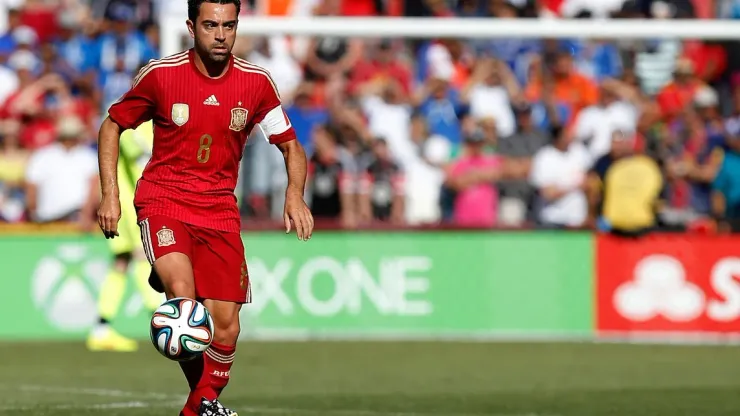
Let’s face it, we live in an age of extremes – and it’s not only due to our unseasonal, severe weather. As soccer continues to evolve in a bizarre, exponential way, seeing that 18 year olds can be sold for £30,000,000 and that a much-hailed Brazilian team can be completely annihilated in the semis of a World Cup hosted on home soil, it goes without saying that even game tactics are bound to put up with similar fortunes. Indeed, two common trends in soccer tactics have surged in the new millennia, teams can either adopt a tiki-taka style of play – or its opposite, a counter-attacking approach.
Tiki-taka is characterized by short passing and movement, usually deployed by a team that is keen on controlling possession of the ball. Introduced by Johan Cruyff during his successful stint as a manager at Barcelona, this slow-paced method has quickly spread outside the Iberian Peninsula as many clubs across the continent have grown fond of it, inspiring the likes of Bayern Munich, PSG and even Welsh club Swansea City, who have made it their bread and butter. This ingenious approach to the game has brought great success to the teams who had faith in it: Barcelona and the Spanish national team are prominent examples as they’ve once dominated as much on the pitch as on the international stage.
On the other hand, some other clubs have a preference for more fast-paced games, combining defensive rigidity with rapid link-up plays. Counter-attacks have always been a known tactic in football, usually deployed at crucial moments of the game when the opposition is so desperate to score that they abandon their defensive composure, leaving behind the perfect opportunity for attackers to work their way through the gaps and cause the final blow. Needless to say, this worth-while effort has greatly evolved since its apparition, becoming a notorious and much-feared approach to the game. It has widely been deployed by small teams during the World Cup, inspired by the tale-like heroics of Chelsea and Real Madrid as both have been crowned Champions of Europe when they resorted to counter-attacking methods.
At present, these two extremes have become almost omnipresent in football as it is in many managers’ convictions that they are the way forward. Nonetheless, only one of these tactics has been fruitful lately – and it’s counter-attacking football. Indeed, Spain’s early exit in Brazil this summer and Barcelona’s trophy-less campaign this season can only hint at the beginning of the end for tiki-taka – leading many pundits to hailing counter-attacking football as the only way forward. Whether possession-oriented tactics are in decline or not, more important questions have surfaced on social media lately: What next for football? Well, if football fans have had enough of both styles, which usually produce a minimal amount of goals during a game (hence, the nap at extra-time), they are advised to have recourse to their history books. Indeed, History has the answer.
It is extremely important to avoid confusion when dealing with the nuance between the spontaneous effort to counter-attack and the clear intention of doing so. In the past, teams who counter-attacked were actually not that boring: it has always been these kinds of fast link-up plays that have kept us on the edge of our seats, hoping that the poacher would somehow miss the target. Counter-attacks are not the problem – parking three buses is. Indeed, having ten men behind the ball, waiting for the right opportunity to intercept it can be quite maddening. And, if one looks closely back in time, they will realize that counter-attacking soccer is not a self-willed action – but a reaction.
When one looks back at the time when tiki-taka football was actually successful, one will come across many soccer fans moaning about this boring style of play. Indeed, success will always be somebody else’s discontent and, the successful, is always advised to remain on guard against bitter, bad losers – who would do just about anything to turn the tables on them. Well, among those losers, a certain Jose Mourinho could be perceived, who prior to his two-legged tie against Barcelona in 2010, had been contemplating a plan to secure his side a place in the final. With that, he did it – on the 28th of April in 2010, Jose Mourinho decoded the Barca Code. The date symbolizes a turning-point in soccer: the game is won by the team who commits fewer errors – and not by those who venture around the opponent’s box. That’s how counter-attacking soccer came to be: all along, it had been an antidote to an equally irritating style of play.
One could only wonder how long this fast-paced approach to soccer will last, but there’s one thing soccer fans are advised to know and it’s that according to Newton, every action has a reaction – and vice-versa.
200+ Channels With Sports & News
- Starting price: $33/mo. for fubo Latino Package
- Watch Premier League, Liga MX & Copa Libertadores
The New Home of MLS
- Price: $14.99/mo. for MLS Season Pass
- Watch every MLS game including playoffs & Leagues Cup
Many Sports & ESPN Originals
- Price: $10.99/mo. (or get ESPN+, Hulu & Disney+ for $14.99/mo.)
- Features Bundesliga, LaLiga, NWSL, & USL
2,000+ soccer games per year
- Price: $7.99/mo
- Features Champions League, Serie A, Europa League & EFL
175 Premier League Games & PL TV
- Starting price: $7.99/mo. for Peacock Premium
- Watch 175 exclusive EPL games per season